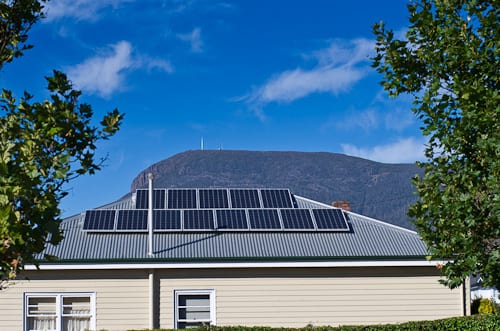As near-record rainfalls deliver Tasmania from a months-long energy crisis, a new report has emerged suggesting that the solar power generated on the state’s rooftops is being seriously undervalued – and that this is holding back the growth of an industry that could bolster energy security and reduce reliance on back-up gas and diesel generators.
The research, released on Friday by the Tasmanian Renewable Energy Alliance (TREA) and Solar Citizens, shows that power generated from rooftop solar in Tasmania is worth between 17-22c/kWh once health and climate benefits are factored in – around three times more than the current price.

Currently, Tasmania’s solar households receive 6.1c/kWh for the solar they export, but pay around 25c/kWh for electricity from the grid, which is mostly sourced from hydropower, but when dam levels fall too low – as they did for the first four months of this year – is generated by gas and diesel, or imported from mainland brown coal plants, when the link to the mainland is working.
In March, the state’s energy minister Matthew Groom hinted that the state’s feed-in tariff may be lifted to try to encourage more rooftop solar and help offset the high cost of diesel generation, which has pushed wholesale prices up to 60c/kWh on some occasions.
TREA and Solar Citizens are now calling on Groom to do just that, and to factor in all of the benefits a high penetration of rooftop solar would bring to the state.
To date, the state’s approach to valuing residential solar has been messy and confounding, culminating in a draft report from the Tasmanian Economic Regulator that recommended little change to the current feed-in tariff.
As TREA chief Jack Gilding wrote here in February, the report did little but demonstrate Tasmania’s “remarkable ability to ignore the challenge of energy security… the changes facing the electricity industry nationally, and the global climate emergency.”
While it acknowledged that solar PV could increase energy security when dams were low, because solar PV supplied only 1 per cent of Tasmanian electricity demand in 2014-15, the report suggested this benefit could be excluded from the FiT calculation.
In stark contrast, the Victorian Essential Services Commission has recently released a report arguing that the price for exported solar should be increased to account for environmental benefits and benefits brought to the grid.
“This is a self-defeating cycle,” Gilding wrote. “Solar PV could meet much more of Tasmania’s energy needs, but until the full benefit is recognised, there will be no incentive for solar owners to invest in feeding energy into the grid.”
In a statement on Friday, Gilding reiterated this point, in the hope the state government will intervene before the Regulator publishes a final solar rate for 2016-2017 that is far below its true value.
“The current price paid to solar households is simply unfair, and it’s holding back Tasmania’s solar industry.
“Grid electricity costs 25c whilst Hydro Tasmania is generating electricity from gas and diesel, sometimes at a cost of between 17 and 30c,” he said.
“A fair price for solar would give Tasmania’s solar industry the boost it desperately needs and would lift jobs, improve energy resilience, provide a fair rate of return and create clean, healthy communities,” said Claire O’Rourke, National Director with Solar Citizens.
“Tasmanians need their government to see the big picture and take decisive action on supporting renewable energy,” said Gilding.
“Burning diesel and gas, praying for rain and importing dirty Victorian electricity is not an acceptable response to Tasmania’s energy situation.”








